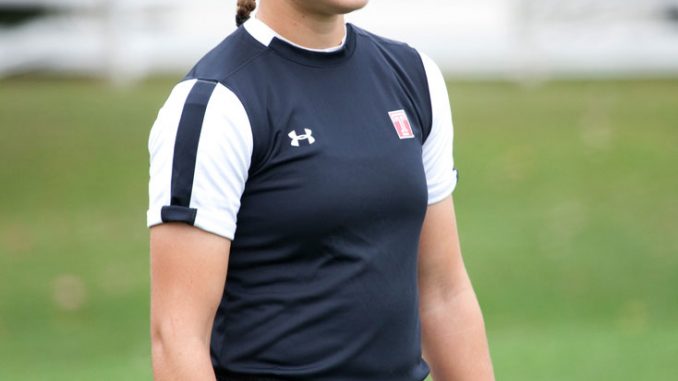
 At 9:12 a.m. on Sept. 11, 2001, Welles Crowther called his mother from the South Tower of The World Trade Center and said, “Mom, this is Welles. I want you to know that I am OK.” That was the last his family would ever hear from him.
At 9:12 a.m. on Sept. 11, 2001, Welles Crowther called his mother from the South Tower of The World Trade Center and said, “Mom, this is Welles. I want you to know that I am OK.” That was the last his family would ever hear from him.
Crowther was an equity trader who saved the lives of as many as 18 people on 9/11 before the South Tower collapsed at 9:59 a.m. In Fall 2011, freshman goalkeeper Shauni Kerkhoff read the story of Crowther, since immortalized as “the man in the red bandana,” and said his exploits on the tragic day dedicated Kerkhoff to a life of helping others and created a new meaning for the garment that she has been wearing every day since she first heard his story.
“Before, I would wear my bandana but it didn’t have a meaning to me,” Kerkhoff said. “Crowther gave a meaning to my headband and has truly inspired me in many ways.”
Crowther had a red bandana with him from the time he was 6 years old through his lacrosse-playing days at Boston College. He would wear the bandana during games to signify courage.
Crowther moved to New York City at the age of 24 and started working as an equity trader for Sandler O’Neill & Partners on the 104th floor of the South Tower. On Sept. 11, Crowther helped a group of people escape safely from the 78th floor to a working elevator on the 61st floor. Instead of riding the elevator down, Crowther went back up to save more people on the 78th floor. At 9:59 a.m., the South Tower collapsed, and Crowther went down as a hero to those he helped survive.
Survivors told The New York Times about how they were saved by a mysterious man who carried a red bandana with him. Crowther was quickly identified in the article by his parents and was honored with the nickname, “The man in the red bandana.”
Kerkhoff had to write an essay for her Temple application on someone who inspires her. After hearing of Crowther’s story a few weeks prior, she said the decision for her prompt was easy.
“The biggest part of the story for me is that [Crowther] realized that the bandana stood for courage,” Kerkhoff said. “His story inspired me right away.”
In the 649-word essay, Kerkhoff explained how she had worn bandanas before she had even heard of the story of Crowther, but he gave purpose to an otherwise trivial practice.
“Crowther inspires me to give my bandanas a meaning. He inspires me to do something meaningful with my life,” Kerkhoff said in her application.
She titled her college essay “The Girl in the Red Bandana.”
Upon arriving at Temple, Kerkhoff had to switch from her normal bandana to a headband during NCAA competition.
Rule 4, Article 5: Section 4 of the NCAA Soccer Rulebook states, “Headgear, headbands, and hats (goalkeepers only) are legal providing they are not considered dangerous to any player.”
“There is not a single day that [Kerkhoff] is not wearing that headband,” said freshman midfielder Katie Burgess, also Kerkhoff’s roommate. “I will be walking around campus with friends and everybody knows her as, ‘The girl with the headband.’”
Kerkhoff now wears a black Under Armour headband in all of her games.
“I think her headband signifies individuality,” junior defender Karly O’Toole said. “It represents something bigger than herself. It represents something tragic, but also something heroic.”
“I have never really seen anybody wear a headband at the collegiate level consistently,” coach Matt Gwilliam said. “It’s not a thing a lot of college players do, but it is what makes [Kerkhoff] unique. A lot of players have their own superstitions and the headband is one of the ways to help her prepare mentally.”
Gwilliam said Kerkhoff had her headband on during the entire recruiting process.
“I think they just believe that it is a part of me so they let it go,” Kerkhoff said.
“I think it gives [Kerkhoff] kind of an edgy look,” O’Toole said. “You don’t really see many girls wearing headbands at the collegiate level and it gives her an individual and different dynamic. I think her look really brings a lot to our team.”
After reading the story of Crowther, Kerkhoff said she knew she wanted to help people. Kerkhoff is majoring in kinesiology and plans to go to graduate school to become a physician’s assistant.
“When I read his story I wanted to do something with my life,” Kerkhoff said. “I wanted to help somebody in some way, and I think that is my way of doing that.”
Crowther was a volunteer firefighter while growing up in Nyack, N.Y., before moving to Boston. After returning to New York to work at the World Trade Center, he soon realized that he couldn’t work in the profession forever, as he had dreams of becoming a New York City firefighter. In 2006, the New York City Fire Department named Crowther a posthumous honorary firefighter, the first such honor given in the department’s history.
By wearing the headband commemorating Crowther, Kerkhoff honors him every day. The last line of her college essay read: “Because of Welles Crowther, I live to be the girl in the bandana.”
John Murrow can be reached at john.murrow@temple.edu or on Twitter @johnmurrow12.



Be the first to comment